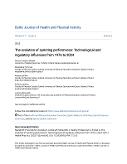The evolution of sprinting performance: Technological and regulatory inflluences from 1976 to 2024

Author
Skalski, Dariusz Tadeusz
Pronczuk, Magdalena
Losinska, Kinga
Publication date
2025Published in
Baltic Journal of Health and Physical ActivityVolume / Issue
17 (2)ISBN / ISSN
ISSN: 2080-1297ISBN / ISSN
eISSN: 2080-9999Metadata
Show full item recordCollections
This publication has a published version with DOI 10.29359/BJHPA.17.2.02
Abstract
Background: This study examines the progression of sprinting performance across the 100m, 200m, and 400m events from 1976 to 2024, highlighting the influence of technological advancements and regulatory changes. Over the past decades, sprinting has been significantly shaped by developments in track surfaces, footwear technology, training methodologies, and regulatory frameworks. Understanding these factors is essential for assessing how sprint times have evolved and what future trends might emerge. Materials and methods: Utilizing a comprehensive dataset from international athletics federations, this research applies time series analysis, regression modeling, and variance testing to assess trends, gender disparities, and performance variability. Data sources include official race results, biomechanical studies, and historical records of rule changes. Analytical techniques focus on identifying patterns of improvement, stabilization phases, and the impact of external factors such as anti-doping policies and equipment innovations. Results: Findings indicate significant improvements in sprint times, particularly during periods of enhanced track surfaces, footwear innovations, and refined training methodologies. Statistical analyses reveal that advancements in material sciences, particularly in track composition and running shoe technology, have contributed to faster race times. However, recent stabilization trends suggest that human physiological limits may be approaching, with marginal performance gains becoming increasingly dependent on biomechanical and genetic optimizations. Additionally, the study highlights the narrowing gender performance gap, driven by advancements in sports science, improved access to elite training, and evolving competition structures. Conclusions: Regulatory measures, particularly in anti-doping enforcement, have played a crucial role in preserving fair competition and influencing performance trends. Future research should explore the interplay between genetic predisposition, neuromuscular efficiency, and emerging sports technologies to determine whether further performance breakthroughs are feasible. The implications of this study extend to athlete development strategies, regulatory policies, and the ethical considerations of performance enhancement in sprinting. This research provides a robust statistical foundation for understanding sprinting evolution and offers insights into the potential trajectories of elite performance in the coming decades.
Keywords
acceleration, elite athletes, sports analytics, training optimization, performance trends,
Permanent link
https://hdl.handle.net/20.500.14178/3108License
Full text of this result is licensed under: Creative Commons Uveďte původ-Neužívejte dílo komerčně-Nezpracovávejte 4.0 International






